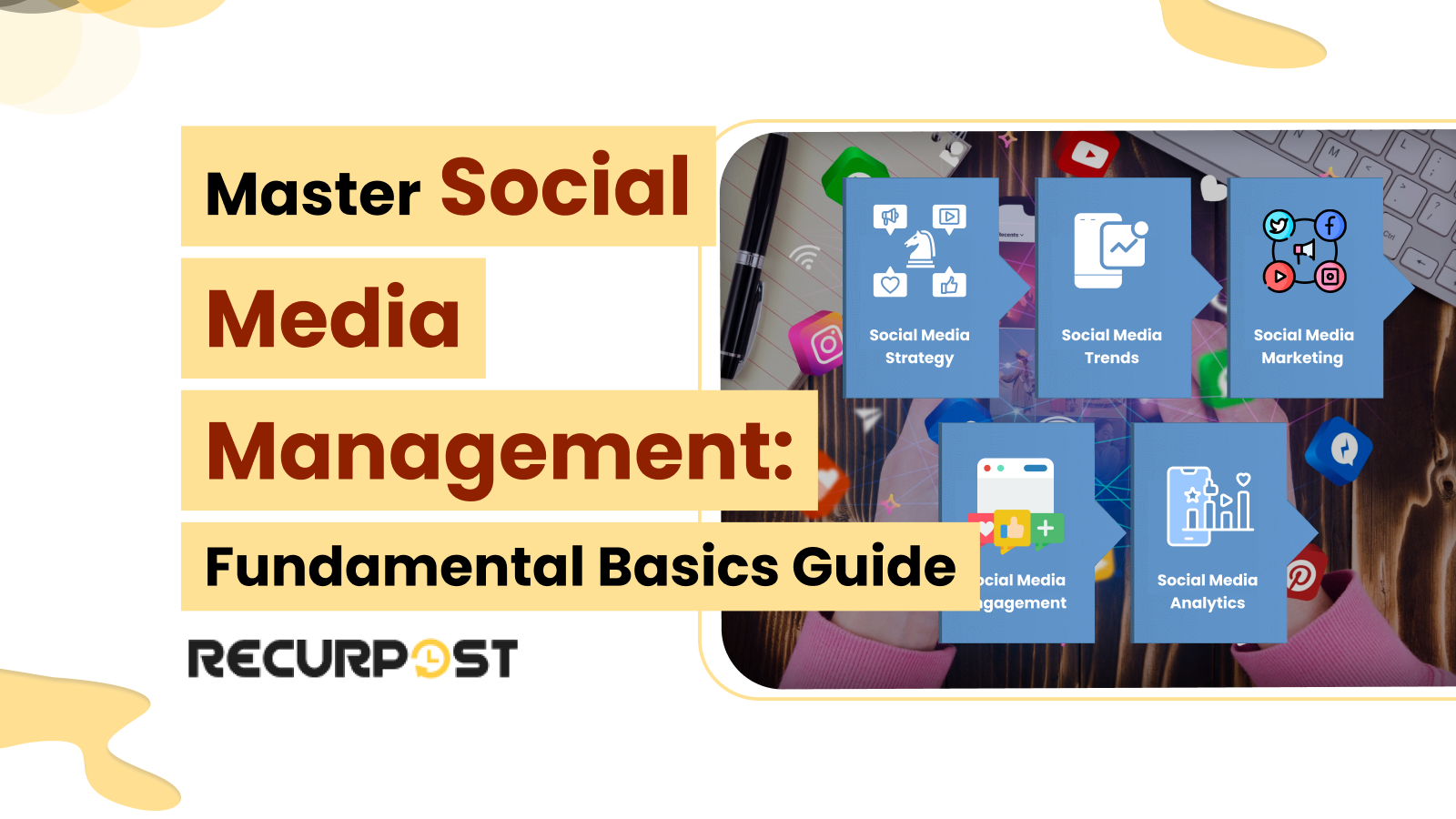Effective social media management includes building a strong online presence. It helps brands schedule and post content, track analytics, and maintain brand consistency across platforms while keeping audience engagement steady.
Social media extends beyond posting to community building. A loyal, engaged audience drives conversations, shares content, and builds trust. Effective community management involves listening, responding, and nurturing relationships that convert followers into brand advocates.
The Fundamentals of Social Media Management
“Social media is about sociology and psychology more than technology.” – Brian Solis
Social media management maintains a brand’s presence on multiple digital platforms. This process encompasses crafting engaging content, scheduling posts, replying to comments, handling DMs, and tracking performance metrics to evaluate effectiveness.
Examples include scheduling weekly posts with social media management tools like RecurPost, responding to customer queries on Instagram, running polls on Stories, and reviewing analytics tracking. These tasks keep brands active, maintain audience loyalty, and enhance social media presence management.
Terms Used in Social Media Management
Social Proof: Social proof in social media management is a psychological phenomenon wherein people follow others’ actions, especially when making decisions. Brands use customer testimonials, user-generated content, and influencer endorsements to build trust and credibility.
Ephemeral Content: Ephemeral content refers to short-lived posts like Instagram Stories, Snapchat Snaps, and Facebook Stories that disappear after 24 hours. This type of content creates a sense of urgency and encourages real-time audience engagement.
Sentiment Analysis: Sentiment analysis uses AI to gauge public perception by analyzing comments, reviews, and brand mentions. It helps brands understand audience sentiment, fine-tune messaging, and respond proactively to feedback.
FOMO Marketing: FOMO (Fear of Missing Out) marketing leverages limited-time offers, exclusive deals, and countdown timers to create urgency. Social media platforms use this strategy in flash sales, product drops, and early access campaigns to boost audience engagement and conversions.
For a full list of social media terms and definitions, check out our Social Media Glossary.
Social media programs: Social media management programs, including master’s in social media online courses, are training programs designed to teach strategies, tools, and best practices for managing and growing a strong brand presence online.
Benefits of Social Media Management
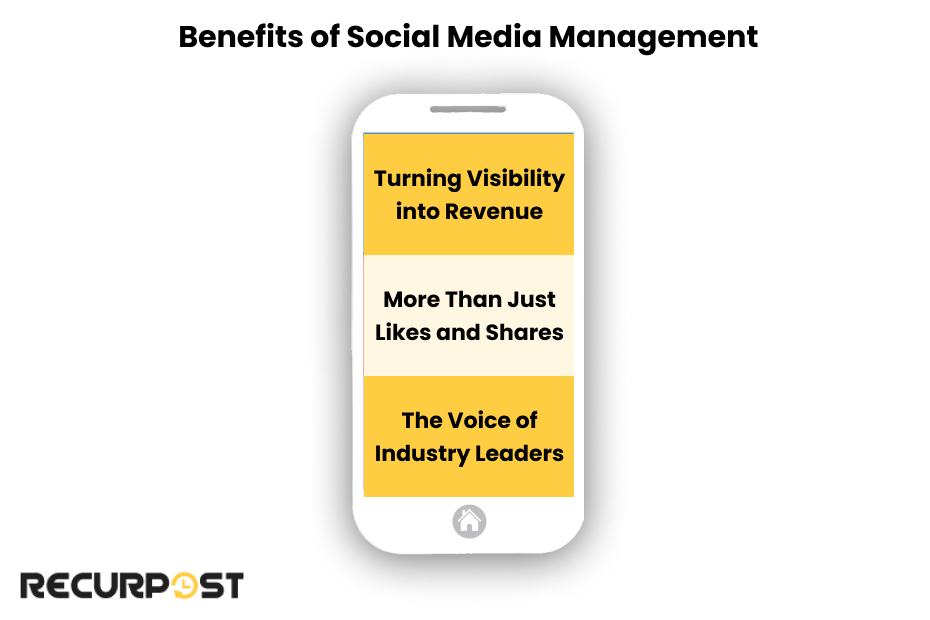
Among its many benefits, here are a few shortlisted:
1. Brand Growth
An active social media presence builds brand visibility, drives website traffic, and generates new customers and revenue. Strong social media management strategies reach target audiences through specialized tools, analytics monitoring, and industry insights that improve audience engagement.
2. Customer Loyalty
A well-managed social media presence fosters audience engagement. Consistent content creation, quick response management, and meaningful interactions strengthen relationships, making social media more than mere likes and shares.
3. Brand Authority
Brands with strategic social media marketing plans earn industry credibility, reinforcing their digital marketing efforts. Sharing industry trends, user-generated content, and expert insights establishes your social media as a space where industry leaders’ voices resonate with their audience.
Social Media Management & Social Media Marketing: Key Differences
| Aspect | Social Media Management | Social Media Marketing |
|---|---|---|
| Purpose | Focuses on maintaining an active social media presence, managing audience engagement, and optimizing content. | Designed to increase brand awareness and drive conversions through targeted social media ads. |
| Core Activities | Creating content, monitoring interactions, and managing multiple social media accounts. | Developing social media marketing strategies, paid promotions, and campaigns. |
| Tools Used | Social media management software, scheduling platforms, and analytics tools to track key performance indicators. | Social media marketing platforms, ad managers, and campaign tracking tools. |
| Success Metrics | Engagement rates, brand reputation, and community management effectiveness. | ROI from campaigns, social media metrics, and lead generation. |
Real-World Social Media Management Examples

Here are its three top examples from the real world:
1. Nike: Mastering Visual Content & Community Engagement
Nike dominates social media platforms with high-quality visual content, influencer marketing, and social listening. Their user-generated content strategy creates a strong brand personality that drives audience engagement across social networks.
2. Starbucks: Personalized Social Media Customer Service
Starbucks enhances customer service through quick response management and real-time engagement on social media platforms. Their management strategy incorporates brand mentions, promotions, and relatable storytelling to maintain a positive social media presence.
3. Netflix: Data-Driven Content Strategy for Engagement
Netflix tailors social media content through data analysis, aligning content with trending topics and audience preferences. Their creative, witty content engages followers across digital platforms, demonstrating the effectiveness of a structured social media management strategy.
More than 54% of social browsers use social media to research products before making a purchase. (Source: GlobalWebIndex)
The Career Side of Social Media Management
Social media management is a booming industry, with many rewarding jobs available.
To land a great social media management role, build a strong portfolio that showcases your best work. Your resume should highlight your key social media management skills, such as content creation, analytics monitoring, and community engagement.
You can enhance your skills with a dedicated social media management course to stay current with the latest strategies. The average social media management salary varies by location and experience, but a strong contract and a clear timeline for projects are essential for a successful career.
Developing A Winning Social Media Strategy
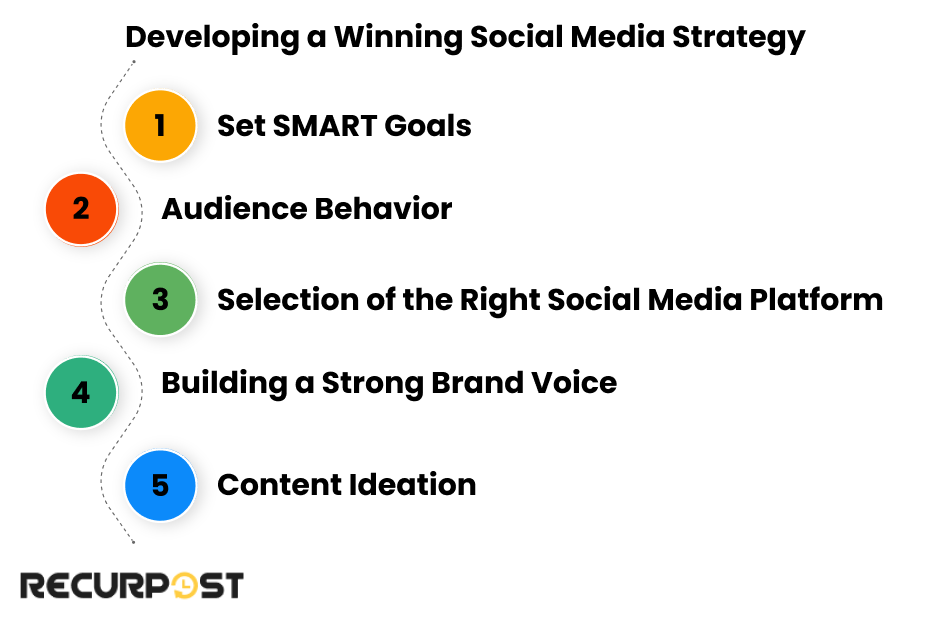
A winning social media strategy forms the backbone of a successful social media management program. This approach simplifies efforts, enhances brand visibility, and creates a consistent presence across multiple digital platforms.
Effective strategy boosts engagement, strengthens brand reputation, and aligns with business objectives for meaningful results.
1. The Roadmap to Social Media Success
Every regional social media marketing strategy starts with SMART (Specific, Measurable, Achievable, Relevant, and Time-bound) goals. This structured approach ensures social media actions contribute to business goals, optimizing efforts for positive brand image and measurable success.
2. Understanding What Makes Them Click
Effective social media management requires knowing your target audience thoroughly. Studying demographics, tracking brand mentions, and using social listening tools reveal which content types trend among your audience.
3. Where Your Audience Lives
Different social media platforms suit different brands. Fashion brands thrive on Instagram and TikTok, while B2B companies excel on LinkedIn. Platform selection depends on audience insights, content type, and marketing plan objectives.
Data analysis from past campaigns and tracking metrics helps businesses maximize reach on relevant platforms, ensuring an active audience engagement.
4. Talk Like a Pro, Engage Like a Friend
Brand voice differentiates your company. Whether witty like Wendy’s or professional like IBM, consistency in your social media strategy ensures strong brand recall. A well-crafted, engaging content improves reputation and develops deeper audience connections.
5. Creativity That Converts
Effective social media management requires innovative content creation. User-generated content, trending challenges, educational posts, and interactive polls within a structured content calendar template create a balanced content mix.
Successful content creation requires staying ahead of industry trends, analyzing metrics, and repurposing top-performing content to maintain a strong social media presence across platforms.
Content Creation & Optimization: Making Every Post Count
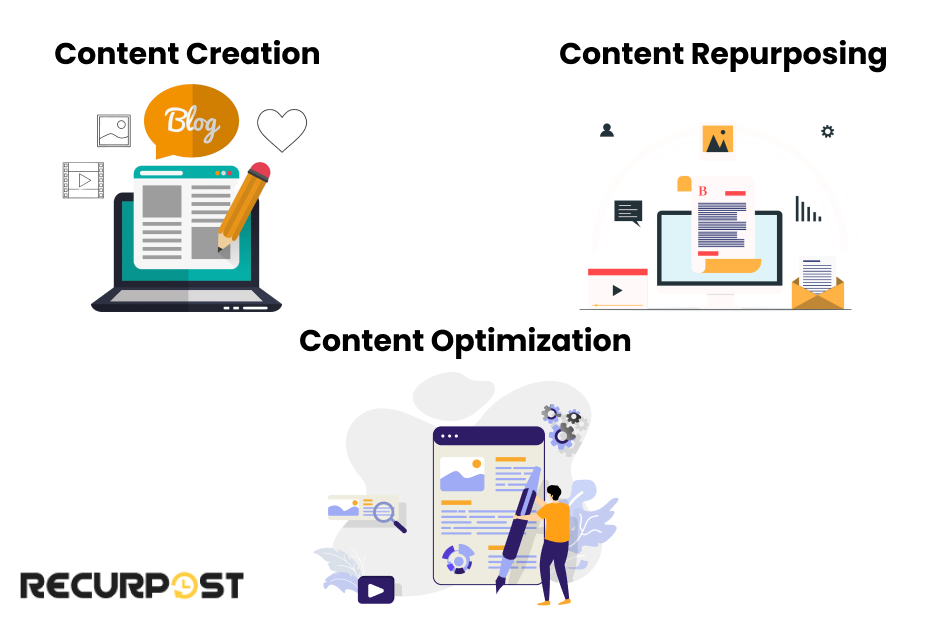
Content creation involves developing engaging material that connects with target audiences across channels.
Eye-catching visuals, such as vector graphics, insightful blogs, and interactive posts, make every publication valuable.
Content optimization maximizes content performance through analytics tools that reveal audience behavior, implementation of marketing best practices, and content refinement for extended reach.
Content Types That Work
“Content is fire, social media is gasoline.” – Jay Baer
Strategic content selection fuels brand presence and drives audience engagement. Key content types include:
1. Short-Form Content: The Attention Grabber
Instagram Reels, TikTok videos, YouTube Shorts, and Facebook Stories deliver quick, engaging, highly shareable bite-sized videos. Short-form content instantly captures attention and increases brand mentions across social networks.
2. Long-Form Content: The Deep Dive
Blog posts, LinkedIn articles, and extended YouTube videos increase brand awareness while providing valuable insights. Long-form content establishes authority, supports SEO, and drives meaningful audience engagement.
3. Interactive Content: Engagement That Converts
Polls, quizzes, live sessions, and Q&As enhance engagement by making followers active participants. Brands using social media listening can leverage interactive content aligning with audience needs. Engagement activities like responding to comments strengthen community management and connections.
4. User-Generated Content: The Trust Builder
Featuring content created by your audience transforms social media marketing effectiveness. User-generated content boosts trust, encourages inquiries, and increases authenticity through product reviews, testimonials, and brand shoutouts. Social media managers can plan this content using calendar tools.
Content Repurposing Strategy: Get More Out of Every Post
Work smarter by letting content do more work. Break blog posts into Twitter threads, infographics, LinkedIn updates, and Instagram posts. Convert YouTube videos into engaging Reels and highlight statistics with visuals. Content repurposing maintains visibility across platforms without constantly creating new content.
Social Media Trends: What’s Hot & What’s Not?
Social media trends constantly evolve, shaping how brands connect with their audiences. Viral short-form videos, AI-driven content, and influencer marketing determine what succeeds on platforms and how ads drive engagement.
1. Instagram: Reels Dominate
Instagram’s social media landscape is all about short-form video content. Reels outperform static posts, making them ideal for brands aiming to strengthen their social media presence, increase brand visibility, and capture audience attention.
2. Facebook: Community Engagement

Organic reach continues to decline, but Facebook Groups and interactive content drive meaningful audience insights. Successful brands focus on community management and hyper-personalized content. Facebook is one of the best social media engagement platforms.
3. YouTube: Shorts
YouTube Shorts compete with long-form videos for social media attention. Brands integrating both formats into their social media management strategy see increased brand awareness and better audience retention.
4. TikTok: Authenticity
@starlight.retreats Your cozy cabin escape awaits at Starlight Retreats on Smith Lake. :herb::sparkles: Our summer calendar is filling up! Click the link in our bio to check availability and book your stay! :black_heart: :movie_camera: @Mariah Noblitt #NatureRetreat #LakeLife #CabinGetaway #VacationRental #TravelInspiration #OutdoorAdventures #LuxuryCabin #EscapeToNature #AirbnbCabin ♬ In Your Arms – Antent
Highly edited, commercial-style videos are out. Brands embracing user-generated content, influencer marketing, and authentic storytelling thrive on TikTok. Raw, relatable content strengthens social media marketing and drives audience loyalty.
Best Social Media Management Tools for Scheduling & Automation
Consistency is mandatory in social media. A steady content flow maintains brand visibility, engages audiences, and supports digital marketing goals.
Automation enables scheduled posts, content repurposing, analytics tracking, and smart distribution while keeping brand voice authentic.
Some of the best social media scheduling platforms are:
1. RecurPost
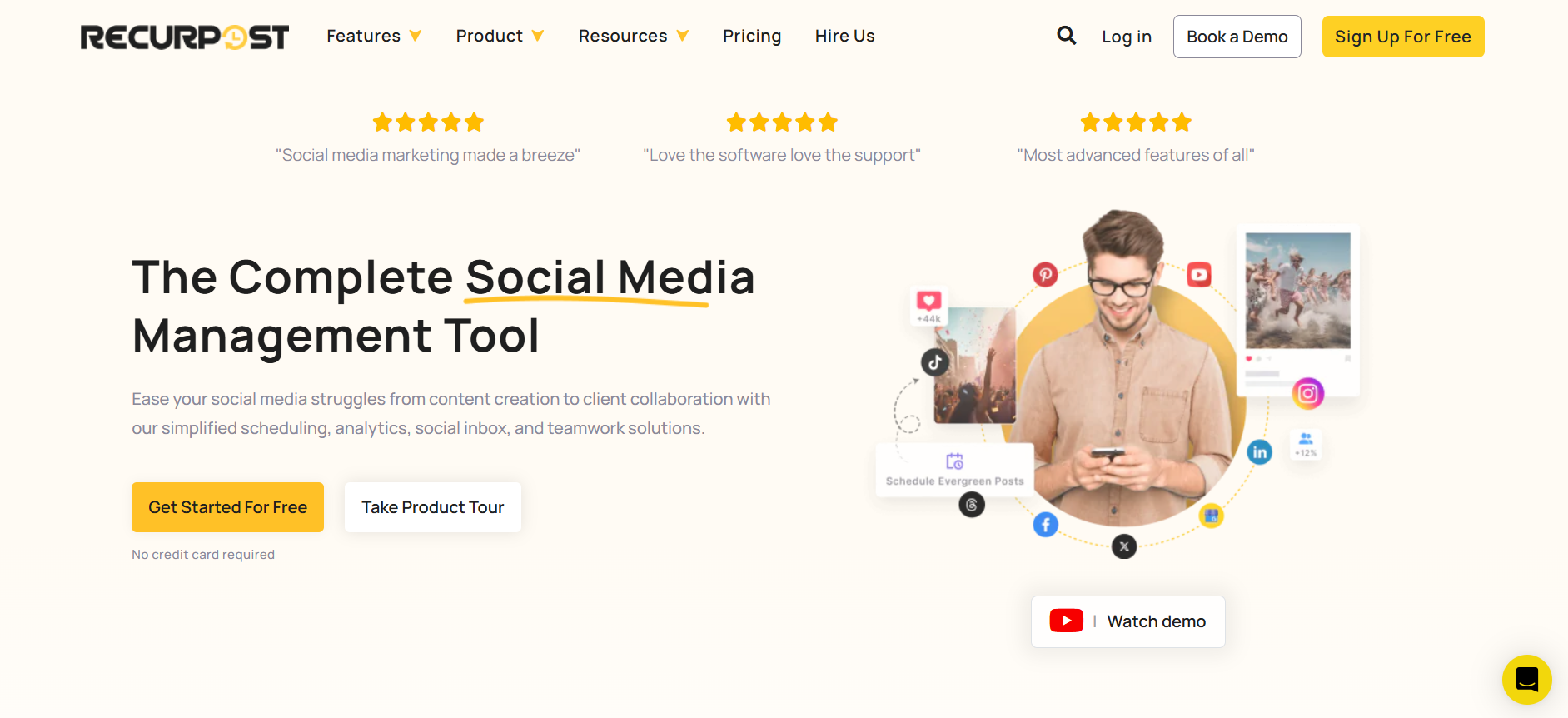
RecurPost is a powerful social media management platform for small businesses, agencies, and brands looking to automate their social media marketing strategies. It allows users to create, schedule, and repurpose content for better audience engagement.
Top Features
- Smart Scheduling: Automates social media posts to ensure maximum brand visibility across multiple social networks.
- AI-Powered Automation: Uses AI-driven analytics tools to find the best times to upload and help businesses optimize their social media strategy.
- Bulk Scheduling: Enhance your brand visibility and engagement with a bulk scheduling planner.
2. Later

Later is a top social media management tool focusing on visual content planning for platforms like Instagram, Pinterest, and TikTok. It simplifies social media content creation by allowing users to schedule posts with a drag-and-drop calendar.
Top Features
- Auto-Publishing for Multiple Platforms: Enables brands to schedule posts on Instagram, Facebook, Twitter, and Pinterest effortlessly.
- Hashtag & Content Strategy Tools: These help businesses analyze data and discover trending hashtags to boost audience engagement.
3. Buffer
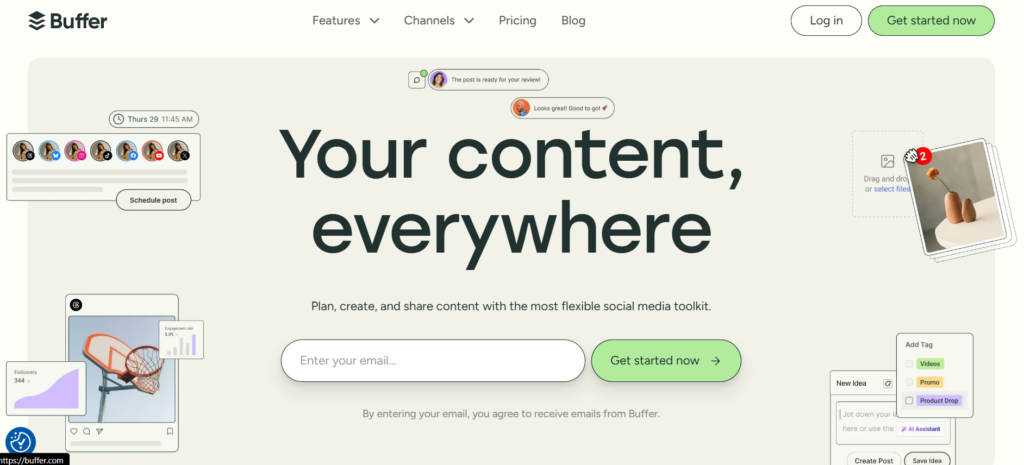
Buffer is a user-friendly social media management software that allows businesses to schedule posts and track key performance indicators across various social media platforms. It’s best for businesses focusing on content strategy and performance tracking.
Top Features
- Multi-Account Scheduling: This feature manages multiple social media channels from a single dashboard, making it ideal for brands handling multiple platforms.
- Performance Insights & Optimization: Offers detailed audience insights and social media metrics to refine social media efforts and boost engagement.
Community Engagement: Building Meaningful Connections
“Your brand is what people say about you when you’re not in the room.” – Jeff Bezos
Online communities build real connections beyond follower counts. Engaged audiences build trust, participate in conversations, and become your brand advocates. Creating engaging content, responding promptly, and valuing people builds relationships, visibility, and customer loyalty.
The Golden Rules of Social Media Engagement
It is the role of the social media team to look into these golden rules.
1. Talk With, Not At, Your Audience
Social media platforms are interactive channels, not billboards. Brands sparking conversations, asking questions, and responding genuinely create deeper follower connections.
2. Be Consistently Present & Active
Social media management requires daily presence. Regular engagement with comments, messages, and discussions maintains brand awareness and builds responsive online communities.
3. Add Value, Not Just Promotions
Followers seek more than advertisements. Sharing useful tips, behind-the-scenes content, and industry insights drives authentic engagement and encourages return visits.
Dealing with Negative Comments & Brand Crises
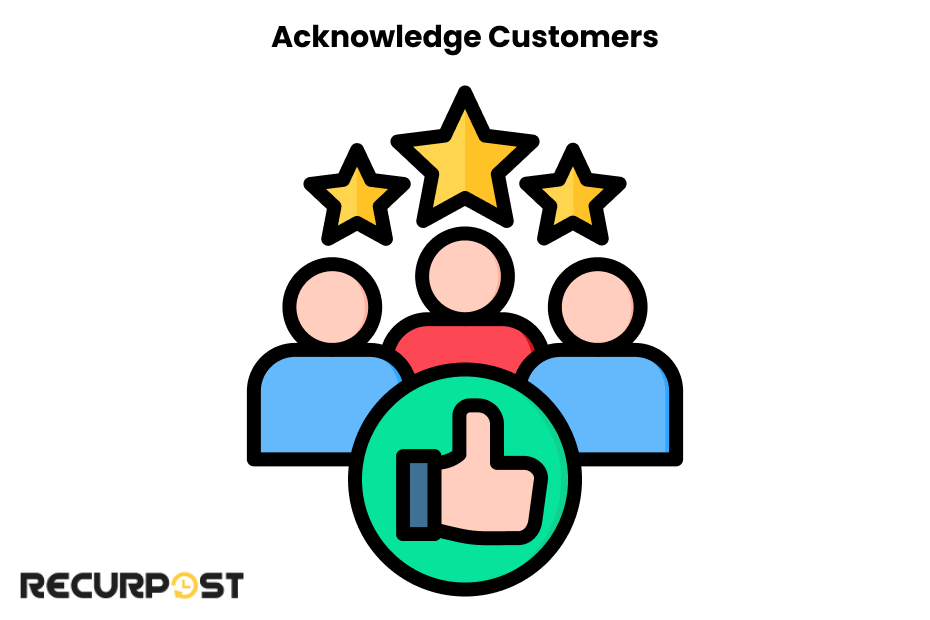
1. Don’t React: Good social media management means staying calm with angry customers. Hear them out, respond with respect, and prevent the situation from growing worse.

2. Take It Offline: For serious issues, move the conversation to direct messages or customer support channels to resolve problems privately and efficiently.

3. Use Criticism: Smart social media management turns negative feedback into an opportunity. Analyze complaints, identify common issues, and use them to enhance your products, services, or communication.
Pricing Your Social Media Management Services
When selling social media management services, it’s crucial to have a professional rate card or pricelist ready for potential clients with a detailed quotation for each project, outlining the scope of work and pricing.
Many professionals offer a monthly social media service package, tiered with different inclusions, often with a clear sheet or diagram that explains what’s included in each tier. For certain global markets’ media management clients, providing local currency pricing (like the Indonesian word for price, harga) can be helpful.
Social Media Analytics
Social media analytics focuses on insights that drive results beyond raw numbers. Tracking key data points helps brands refine strategies, optimize content, and build a strong online presence.
Social Media Metrics
Social media metrics reveal audience behavior, content effectiveness, and platform performance. These metrics help managers evaluate software efficiency and optimize campaigns and audience engagement strategies.
Some of the commonly used social media engagement metrics measurement ensuring successful social media management are:
1. Engagement Rate: Measures how actively users interact with content through likes, shares, comments, and saves. A high engagement rate indicates strong community engagement and audience loyalty.
2. Reach & Impressions: Reach metrics in social media management track unique viewers, while impression statistics count total views. Tracking these helps brands understand content visibility and brand awareness.
3. Conversion Rate: Shows how many users take desired actions after seeing a post, like signing up, purchasing, or clicking a link. A high conversion rate means effective content and audience targeting.
Paid Advertising in Social Media: Scaling Beyond Organic Reach
Paid advertising complements organic social media marketing when broader visibility is needed. From product launches to retargeting campaigns, social media ads accelerate growth and reach target audiences faster.
Types of Social Media Ads
Effective ad use requires clear objectives, precise demographic targeting, and continuous performance optimization for ROI improvement. Ad types include:
1. Display Ads
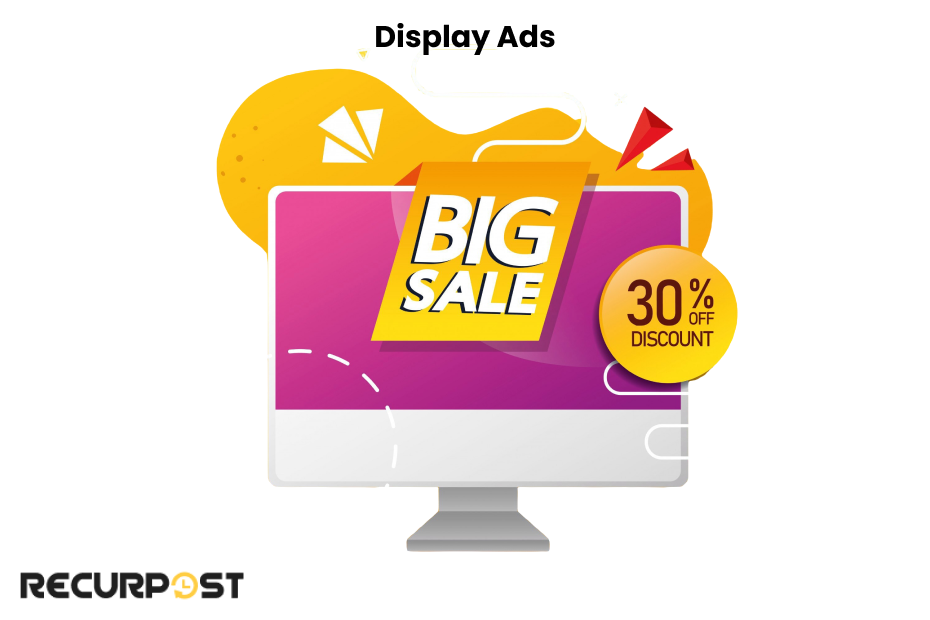
These are visually engaging banner-style ads appearing across social media platforms like Facebook, Instagram, and LinkedIn. These media ads are perfect for brand visibility, showcasing products, and attracting attention with compelling visuals.
2. Sponsored Content Ads

These ads blend naturally into users’ feeds, appearing as promoted posts. They boost engagement, increase visibility for organic content, and are commonly used on LinkedIn, Facebook, and Instagram for lead generation and traffic growth.
3. Retargeting Ads
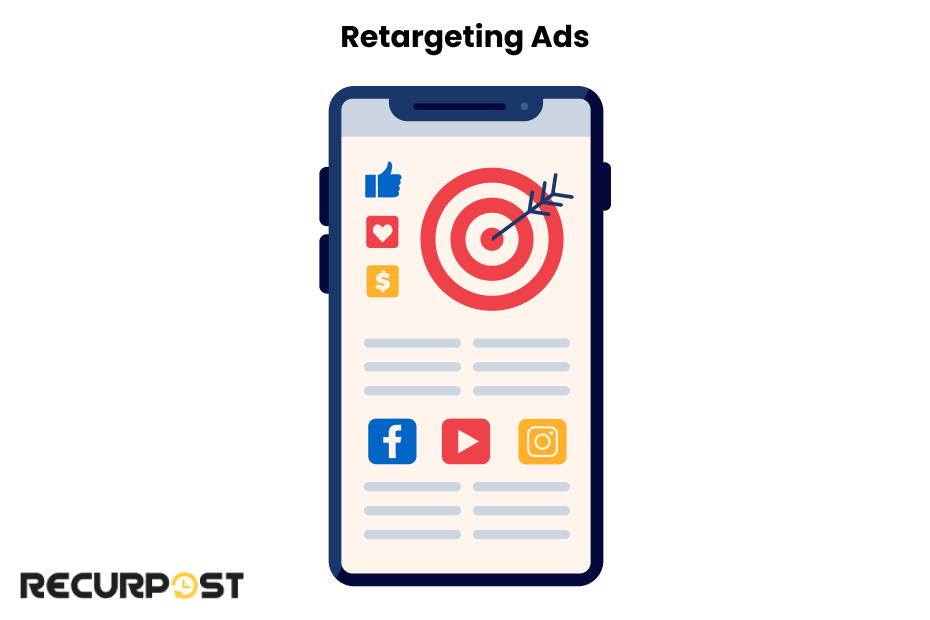
Designed to engage with customers on social media who have previously interacted with a brand, these ads remind potential customers about products they viewed or abandoned in their cart. They work well on Facebook, Instagram, and Google Display Network to drive conversions.
Tip: Use Lookalike Audiences on Facebook & Instagram to reach potential customers similar to your best existing ones.
Budgeting & Measuring ROI on Social Ads
Clear budgeting for media management maximizes results without overspending. Begin with small test ads, track performance, and make adjustments. Target audience engagement based on interests, behaviors, or past interactions.
Precise audience targeting increases engagement and conversions. Measure ROI through clicks, conversions, and customer acquisition costs. Regular optimization ensures ads deliver value and maximum returns.
Building your brand’s presence is just the first step. Want to take it to the next level? Discover the secrets of social media optimization to boost your reach, engagement, and visibility like never before!
In Conclusion
Managing social media means optimizing each platform for its unique strengths. You can also save this social media management PDF for future reference.
- Facebook is key for community building and customer engagement through posts, groups, and ads.
- Instagram thrives on visuals, where aesthetics, reels, and stories enhance brand presence.
- Twitter (X) is all about real-time conversations, making it ideal for updates and brand voice.
- TikTok dominates short-form, viral content, helping brands connect with a younger, highly engaged audience.
Effective social media management also means being prepared for unexpected challenges. Quick, transparent communication and active listening while handling a crisis in media management, such as backlash from an ad, can help rebuild trust and protect the brand image.
FAQs on Social Media Management
1. What are the common mistakes to avoid in social media management?
Common pitfalls in social media management include:
– Lack of a Clear Strategy: Posting without a defined plan can lead to inconsistent messaging and missed opportunities.
– Ignoring Audience Engagement: Failing to interact with followers can make your brand appear unapproachable.
– Overemphasis on Follower Count: Chasing follower numbers instead of quality can result in weak audience engagement.
2. How to post on all social media at once, which helps in better social media management?
To post on all social media at once, use tools like RecurPost, Buffer, or Hootsuite. They let you schedule and publish content across platforms in one go. This simplifies your workflow and ensures consistent, well-managed posting.
3. Which platform would be best for connecting with journalists?
Reddit is a great platform for connecting with journalists, especially in niche subreddits like r/Journalism or r/Media. Engaging in meaningful discussions through this social platform can help build authentic connections. The best times to post on Reddit are 6–9 AM when user activity peaks.
4. What are the future trends and innovations in social media management?
Emerging trends include:
– The Rise of Social Commerce: Integrating shopping experiences directly into social platforms for seamless purchasing.
– Decentralized Social Media & Web3: Shifting towards user-owned networks, enhancing privacy and control.
– AI & Chatbots: Utilizing artificial intelligence for personalized content and automated customer service.
5. What are some essential social media management tips for success?
To excel in social media management, focus on creating high-quality, engaging content, posting consistently, interacting with your audience regularly, and tracking performance metrics to refine your strategy.

Debbie Moran is a Digital marketing strategist with 5+ years of experience producing advertising for brands and helping leaders showcase their brand to the correct audience. She has been a part of RecurPost since 2019 and handles all the activities required to grow our brand’s online presence.

